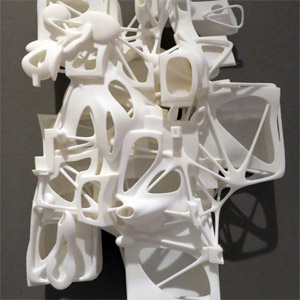 NEWS
NEWS
 NEWS
NEWS
 NEWS
NEWS
![]() Slowly but surely, 3D printing is becoming a part of how computer-generated-art intersects with reality (in the same way it will cause a collision for copyright vs. reality and gun control with culture) and adding to the newest reification of computer-aided design and sculpture is Kevin Mack’s upcoming show at the PS ZACK art gallery.
Slowly but surely, 3D printing is becoming a part of how computer-generated-art intersects with reality (in the same way it will cause a collision for copyright vs. reality and gun control with culture) and adding to the newest reification of computer-aided design and sculpture is Kevin Mack’s upcoming show at the PS ZACK art gallery.
According to Mack, his designs are generated on computer and then the physical sculptures rendered into tacticle fact with 3D printing technology:
My images, sculptures and animations are created using a variety of digital tools. Digital painting and sculpting are incorporated with procedural techniques such as functional modeling and fluid dynamic simulation. Physically based rendering, which simulates the behavior of light, makes it possible for me to make virtual photography of my creations and discoveries. Selected images are printed on canvas and paper. Physical models of my virtual sculptures are produced using 3d printing technology.
My process integrates intuition and intellect – deliberate design and random happenstance – realism and abstraction – humanity and technology – art and math – science and mysticism – philosophy and humor.
This adds Mack’s artwork to an already growing list of potentially awesome uses of 3D printers including these organic life-like sculptures from Colony and this list of three interesting other designs as well—a Nokia Lumia 820 case, the Creators Project, and CrayonCreatures.
My vision for immidiate 3D-printing includes everything from the production of prototypes in garages for aspiring inventors to printable-and-paintable miniatures for tabletop RPG geeks (and this could include aficionados who make model trains or even recreations of famous events.) This is still thinking small, right now 3D printers are small-ish in size, they’re expensive, and while they’re moving into retail they’re producing toys and prototypes.
However, what we’re seeing with Mack’s artwork and the rise of the physible—downloadable schema that can be printed in a 3D printer—is only the tip of the iceberg. As 3D printers industrialize and our materials science begins to catch up, we will be able to fabricate larger and more interesting objects. And, given the nature of modular thinking, it’s easy to see that eventually we’ll be able to print entire houses (although not all at once).
Every new use of 3D printers, even the esoteric or artwork, brings the products ever closer to the mainstream and further into the public consciousness. Eventually, we might even see kiosks at the local supermarket waiting to receive a USB stick or the tap of a touchscreen to produce an object that can be bought there and carried home.
More artwork from Kevin Mack for you to peruse.
Support our mission to keep content open and free by engaging with theCUBE community. Join theCUBE’s Alumni Trust Network, where technology leaders connect, share intelligence and create opportunities.
Founded by tech visionaries John Furrier and Dave Vellante, SiliconANGLE Media has built a dynamic ecosystem of industry-leading digital media brands that reach 15+ million elite tech professionals. Our new proprietary theCUBE AI Video Cloud is breaking ground in audience interaction, leveraging theCUBEai.com neural network to help technology companies make data-driven decisions and stay at the forefront of industry conversations.